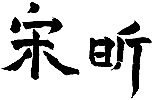Noticing
Xin Song’s taste for drawing, her mother sent her to
the local community center for children in the Haidian district
of the Zhongguanchun area in Beijing. At 14, Xin Song
was the youngest in the class. She learned calligraphy and
drawing during the weekends and summer vacation. Being with
older, more experienced children, taught her to overcome difficulty
and, later, gave her the self-confidence to apply to an art
school. In 1990, Xing Song majored in Fine Art at Beijing Haidian
Art School where she learned the basic tools of painting, drawing
and understanding color, all skills an artist needs to pursue
a career in art.
 One of Xin Song's early paper-cuts
One of Xin Song's early paper-cuts |
“At
that time, I was 18, and I went to Yuan Ming Yuan where many
art students spent time doing landscapes, much like
the 19th century French Impressionists. The mother of one of
my teachers was a nurse and she had left a pair of surgical
scissors lying on a piece of paper. I took the scissors and
I started cutting the paper! People around me thought that
I knew paper-cut, but I was not familiar with the technique.” Intrigued,
she started to go to the library and discovered that paper-cut
is common in China and that different provinces have developed
different themes, some very humble like flowers, birds, children
playing and others more elaborate such as the Zodiac signs
or characters from the Beijing opera.
Xin Song had just graduated from the Fine Art School and she
spent the summer experimenting and enjoying paper-cut. It was,
as she said, “a happy time, a happy summer,” a
moment when she could let everything go and express herself
naturally. She was inspired by the simple life of the rural
areas: birds, fruits, fields, farmers working side by side,
rivers, took shape with the blades of her scissors following
the course of her imagination.
 The cover of Xin Song's first book
The cover of Xin Song's first book
|
She did
almost 200 paper-cuts. A publisher noticed her drawings and
put them in a book, which
sold 7,500 copies. Today, the book is out of print and Xin
Song never learned what happened to the drawings that were
also bought by the publisher! The book opens with double
pages that form a story.
What Xin Song learned either by experimenting herself or,
later, by doing paper-cut with farmers, is to develop a
story in an unbroken line. The story is told with
the precision of the gesture: a slight mistake and everything has to be done
again, an extravagance in a poor economy.
It is at the Central Academy of Fine Arts (CAFA) in Beijing
that Xin Song fulfilled her dream of acquiring a deeper
knowledge of paper-cut. Chinese universities
began offering departments of folk art after the death of Mao Zedong. She was
extremely lucky to study with Lu Shengzhon, an artist who turned paper cutting
into a fine art. He prevented it from being submerged in the commercial production
for tourists. With Lu Shengzhon, Xin Song sensed that she could shape an enchanting
world that would not be frozen into tradition, but which could grow into an
artistic statement. The pulse of New York would provide
her that.
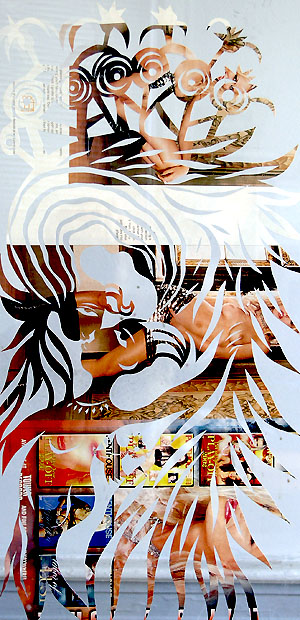
"Life=Sex?"
Series, Paper-cut with magazine collage, 12"x26", 2007,
© Xin Song |
“ Before, I usually used Chinese red paper or a plain white paper. When
I arrived in New York, I saw the magazines that people buy, read rapidly and
throw away. I thought I could recycle them and bring them back in another manner,” says
Xin Song.
The first difference with publications in China she saw was the pornographic
press. She was shocked to realize that these magazines were on sale in
public places. Children could see them, and she thought that they were
too young, too
innocent, to be exposed to that.
Xin Song saw this as a question rather
than a statement. She was curious to understand the difference. She started
to collect
porno magazines that she found in dumpsters and she cut the images, asking
herself in which way she could put the pieces together.
“When you look at these
magazines,” remarks Xin Song, “you see the sexual element right
away. When you cut the images, you cut them into elements. You select what
should be
in your story. You reflect on the way you were brought up and educated.
Not just me, as a Chinese, everybody. I think that by fragmenting the image,
I
can make
things more attractive, more seductive. People can see things differently
because it requires attention, another type of attention.”
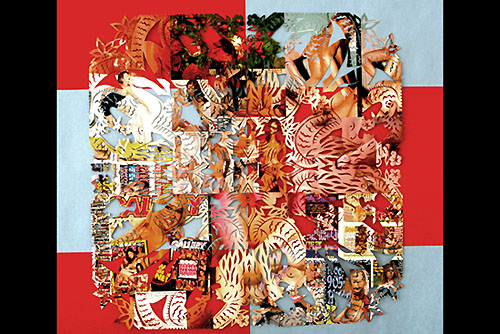
"Life=Sex"
Series, Paper-cut with magazine collage, 36"x36", 2007,
© Xin Song |
Later,
Xin Song developed the Tree of
Life Series. “I transformed
the pornography into the Tree of Life, because making a life
is sexual, but after that, life
grows as a tree does,” she explains.
The Tree of Life is an important cultural and spiritual component in nearly
all cultures. The use of a tree as an element of connectivity is revealing
of our
times.

"Tree of Life" Series, Paper-cut with magazine collage,
© Xin Song |
Xin Song
now finds images in all sorts of magazines: travel, fashion, computer,
food and others. The images from these
magazines give the artist
a sense of what the public is being exposed to.
The myriad sources that she uses
embody the directions in which we are being uncontrollably
driven. The images belong to a world in which everything
has to move
quickly. We do not have much time to buy the latest design
before it looks out of date. Resolutely and as
a counter-offensive, it takes Xin Song two months
of work to finish a Tree of Life and the visual effect
is astonishing. From a distance, we can recognize
the branches, the leaves, a bird flying, a flower
in full bloom, peacocks snatching snakes. We can decide
to relax and to see it from a distance. It is peaceful.
But, our curiosity can also entice us to look
more closely and to discover that
the colors come from fragments of images and
texts. In our mind, we can try to recompose where the image
came
from and what the context was. It is a way
of
restructuring the world of consumerism and media.
But, deconstructed, we have another understanding that
has to be carefully deciphered.
“People can look at me as a woman who stays at home and spends her time
looking at magazines,” explains Xin Song. “But, for me, there is
more here. The media, the advertising companies work on the idea of a woman staying
at home, especially when she has children. I read the information in a different
way. I look at a written piece describing Cuban children using guns at an early
age. I can take it as pure information, a frightening information. But, what
is the real purpose of the magazine? I start to put these questions, these fragments
together…and there is a tree.”
In Xin Song’s vision of the Tree of Life there is a deep connection with
Chinese language in which one character represents a tree and doubling the same
character means forest. We have the “I” as
the center: we are a tree, then we become a forest
and people
become the
world. It is
the
essence
of the
cycle of life: things grow and take another configuration.
It was most probably a necessary step for Xin
Song to take. With
a tree,
one gets
roots and a balance;
something that she needed as a woman between
two worlds. The shape of the tree, composed of
different
parts
coming from
imaginary places, links
us
with the
notion of growth.
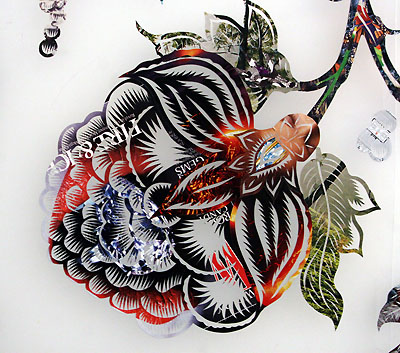 Detail of "Tree of Life" Series, © Xin Song
Detail of "Tree of Life" Series, © Xin Song |
|
 Detail of "Tree of Life" Series, photo © Michèle Vicat
Detail of "Tree of Life" Series, photo © Michèle Vicat |
Not much was needed for Xin Song to take the
next step, to fragment even more finely the
information circulated through the media and
to space it out in
a visual field without any limit. Transformation is a series that brings us to
a solitary journey. The tree is no longer there
as a visual anchor. Xin Song found connections
with American folk art, and especially the
art of quilts,
which is also done mainly by women. Transformation is composed as a floral quilt whose
flowers and branches lead us first into a Garden
of Eden. The closer we get, the more we find
strange, even unsettling elements inside the
floral contours.
The artist wants us to look at things, but
not in a defined way. The patterns are composed
of fragments of objects from our contemporary
society, a society
that lives at a certain point in time.
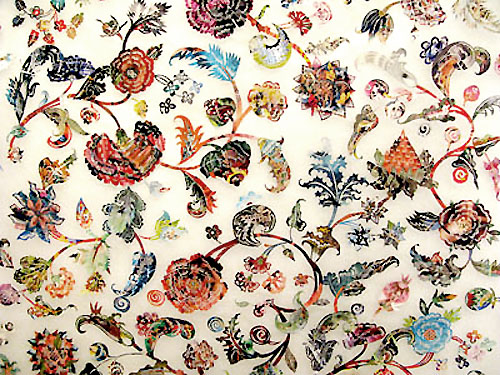 "Transformation," Paper-cut with magazine collage, tracing
paper,65"x80", 2008, photograph © Michèle Vicat
"Transformation," Paper-cut with magazine collage, tracing
paper,65"x80", 2008, photograph © Michèle Vicat |
Today,
people are very oriented toward technology.
A computer represents technology. Take a
computer apart and you
fragment the technology. What do we need
exactly? Magazines may try to convince us
that
a computer was created to change the society
as well as the way we should look at our
self-improvement. But, what do we finally
take from that? What
the magazine
is doing is to vehicle an image of an era.
It is up to us to accept its interpretation
or reject it. It is a bit like negotiating
the translation of a word in a dictionary.
Several possible choices add to our perplexity.
Which one do we chose? Which term best captures
our intimate sense of the word? The paper-cut
images of
Xin Song are already a patchwork of our daily
visual, auditory, sensorial routines. Xin
Song extracts what touches, shocks and provokes
her the most. What she
offers
us is an aggregation of her vision, it is
the
vision that a bird has when it flies high
over a field.
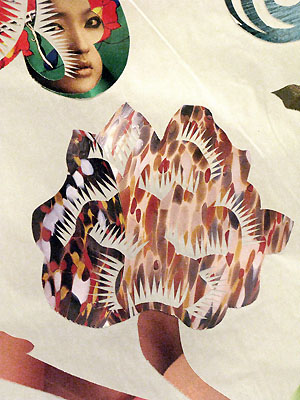 Deatil
of "Transformation,"
Deatil
of "Transformation,"
photograph © Michèle Vicat |
The chocolate-flower,
a detail of Transformation (see image to the right),
captures Xin Song's thoughts about celebrations: “This
is something you produce for Easter,
for example. I think that in this world some people are rich
and can pay as much as a thousand of dollars for chocolate,
while other people cannot afford
basic food. Where is the frontier between luxury
and fundamental need? This is the
conversation I have with an image when I look at a magazine.
What does the image vehicle exactly?” The
question takes on its importance
when magazines are thrown away,
torn into
pieces,
reduced
into a pulp, then recomposed as
paper to lay out the icons of our
latest
trends. In Transformation, Xin
Song lays out
the
broken
pieces of our full illusions. |
